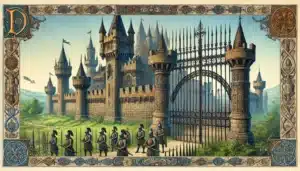As we stand at the crossroads of modern living and environmental responsibility, it’s becoming increasingly clear that every choice we make in our homes can leave a lasting imprint on the planet. Eco-friendly practices in home improvement aren’t just a trend; they’re a necessary step towards a sustainable future. But it’s one thing to hear about the importance of going green and another to see its impact firsthand.
I remember a job I worked on not too long ago. We were tearing down an old fence to put up a new one. It was just another day on the job until I noticed something: the amount of waste we were creating. The old, treated wood – warped and soaked with chemicals – was destined for the landfill, and it struck me. Here was this material that had once been a living tree, turned into something harmful to the earth. That got me thinking. What if we did this differently? What if our fences could reflect a respect for the environment, not just mark the boundaries of our property?
This revelation led me down a path of discovery, exploring eco-friendly fencing options that not only do their job but also do right by the planet. And let me tell you, what I found was not only eye-opening but also heartening. Join me as we delve into the world of green boundaries – where the fences we build can be a testament to our commitment to the earth, not a burden upon it.
The Environmental Impact of Traditional Fencing
When we talk about fencing, the usual suspects are treated wood and vinyl. They’re everywhere, and for good reasons – they’re durable, they look decent, and they get the job done. But here’s the rub: the environmental cost of these materials is something we can’t ignore.
Treated wood, for instance, is a staple in fencing. It’s wood that’s been infused with chemicals to resist rot, insects, and weather damage. Sounds good for longevity, right? But these chemicals can be harmful to the environment. They can leach into the soil, contaminating it and potentially affecting the local water supply. Then there’s the issue of sourcing the wood. Deforestation for timber is a real concern, impacting wildlife habitats and contributing to climate change.
Vinyl fencing is another popular choice. It’s low maintenance and can last a long time. However, vinyl is a type of plastic, and we all know the story with plastics. They’re derived from non-renewable petroleum products and their production releases harmful chemicals into the atmosphere. Plus, at the end of its life, vinyl fencing often ends up in a landfill where it doesn’t decompose, adding to the mounting problem of plastic waste.
I remember working on a fencing project in a quaint little neighborhood. We were replacing an old wooden fence with a new vinyl one. As we pulled out the old, chemical-laden wood, I couldn’t help but notice the dead patch of grass where the fence stood. The chemicals had done their job alright, keeping the fence standing but at what cost to the soil and the plants that once grew there? And as we put up the vinyl fence, I thought about where it would end up decades down the line. Would my kids or grandkids have to deal with it in a landfill?
That job was a turning point for me. It made me realize that as a worker, a homeowner, and a part of this community, I had a role to play in protecting our environment. It was time to look for alternatives that don’t just serve our immediate needs but also consider the long-term health of our planet.
Exploring Eco-Friendly Materials
In the quest for environmentally responsible fencing options, I stumbled upon some materials that are not just kind to Mother Earth but also tick all the right boxes for durability and aesthetics.
Bamboo Fences: First up is bamboo. Now, this isn’t your average backyard weed. Bamboo is a superstar in the world of sustainable materials. It grows incredibly fast, which means it can be harvested frequently without causing deforestation. This rapid growth cycle makes bamboo a renewable resource par excellence. As a fencing material, it’s surprisingly sturdy and can withstand the elements pretty well. Plus, it has a natural, earthy look that can blend seamlessly into any garden or backyard. I worked on a bamboo fence project last summer, and let me tell you, it was a breath of fresh air to handle material that felt so ‘alive’ compared to the usual stuff.
Recycled Plastic and Composite Fencing: Next, let’s talk about recycled plastic and composite fencing. These materials are like the phoenix of the fencing world – born from the ashes of consumer waste. Recycled plastic fencing is made from old plastic products, giving a second life to materials that would otherwise clog up our landfills. Composites, on the other hand, are a mix of recycled plastic and wood fibers. They combine the best of both worlds – the durability of plastic and the natural look of wood. I recently worked with composite materials for a small garden fence, and the ease of installation was a game-changer. Plus, knowing that we were reducing plastic waste felt pretty darn good.
Living Fences (Hedgerows): Lastly, we can’t talk about eco-friendly fencing without mentioning living fences, or hedgerows. This is as natural as it gets – using plants to create a boundary. Hedgerows can be made from a variety of shrubs and trees, depending on the local climate and soil. They’re great for the environment, providing habitats for wildlife and helping to improve air quality. Plus, they look stunning throughout the seasons. I had the chance to help set up a hedgerow for a client who was an avid bird watcher. By the following year, it had become a mini sanctuary for birds and insects, turning a simple boundary into a bustling hub of nature.
In each of these materials – bamboo, recycled plastics, and living fences – there’s a common thread. They show us that making environmentally conscious choices doesn’t mean compromising on quality or aesthetics. If anything, it opens up new avenues for creativity and connection with the environment around us.
Read More: The Unexpected Charms of Corrugated Metal Fencing
DIY Eco-Friendly Fencing Projects
Rolling up your sleeves and building a fence yourself can be incredibly rewarding, especially when you’re doing it with eco-friendly materials. Here’s a quick guide on how to build a simple bamboo or recycled material fence, along with some tips I’ve picked up along the way.
Building a Bamboo Fence:
- Materials: Get your hands on some quality bamboo poles. You’ll also need galvanized wire or screws, and tools like a saw, drill, and wire cutters.
- Design: Decide on the design. Do you want a traditional Japanese style, or something more modern? Sketch it out.
- Framework: Start by setting up posts at regular intervals. These can be made of bamboo or other sturdy materials.
- Attaching Bamboo: Drill holes through your bamboo poles and secure them to the posts with wire or screws. Keep it tight to prevent wobbling.
- Personal Tip: To keep the bamboo looking good, treat it with a natural oil or a low-VOC sealant.
Building a Fence with Recycled Materials:
- Materials: Source recycled plastic or composite fencing materials. Many suppliers offer panels or boards made from recycled plastics.
- Preparation: Just like with any fencing project, prepare your area and set your posts. Make sure they’re sturdy.
- Installation: Follow the manufacturer’s instructions to attach your panels or boards to the posts.
- Personal Tip: Don’t hesitate to mix and match materials. For instance, using wooden posts with recycled panels can create a unique look.
Cost-Effectiveness and Satisfaction: Building a fence yourself with these materials can be more cost-effective than you’d think. You’re not just saving on labor costs; you’re also investing in materials that last longer and require less maintenance. Plus, there’s the satisfaction of having built something beautiful and environmentally friendly with your own hands.
Maintenance and Longevity of Eco-Friendly Fences
Maintaining these eco-friendly fences is crucial for ensuring their longevity, and thankfully, it’s not too demanding.
Bamboo Fence Maintenance:
- Regularly check for signs of mold or mildew, and clean with a mild soap solution.
- Reapply a sealant or oil every few years to protect against weathering.
- Bamboo can split over time, so be prepared to replace individual poles as needed.
Recycled Material Fence Maintenance:
- Recycled plastic and composite materials are pretty low maintenance. A simple wash with soapy water usually keeps them looking new.
- Check for any loose boards or panels annually and tighten as necessary.
Living Fence Maintenance:
- Regular pruning is key to maintaining the shape and health of your hedgerow.
- Keep an eye out for pests or diseases and treat them promptly to prevent spreading.
- Water your living fence during dry spells, especially in the first few years as it establishes.
Long-Term Benefits: Choosing these sustainable materials for your fencing project isn’t just a short-term solution; it’s an investment in the future. For instance, on a project last year, we replaced a traditional wooden fence with a composite one. A year later, the composite fence still looks as good as new, while the old wooden one needed regular treatments and repairs. These eco-friendly options reduce the need for frequent replacements or repairs, saving resources and time in the long run.
By choosing and maintaining these eco-friendly fences, we’re not just marking boundaries; we’re setting a standard for a sustainable and beautiful living space.
Beyond the Fence – Other Eco-Friendly Home Improvements
Eco-friendly fencing is just the beginning. There are numerous other ways to make your home more sustainable and environmentally friendly.
Solar Panels: One of the most impactful changes you can make is installing solar panels. They reduce reliance on fossil fuels and can significantly cut down your electricity bills. The upfront cost is offset by long-term savings and the satisfaction of using renewable energy.
Rainwater Harvesting: Another simple yet effective eco-friendly practice is rainwater harvesting. By collecting and using rainwater for your garden, you can conserve a significant amount of water. Plus, your plants will love it!
Energy-Efficient Appliances and Lighting: Upgrading to energy-efficient appliances and LED lighting can reduce your energy consumption and save you money in the long run.
Insulation and Eco-Friendly Building Materials: Improving your home’s insulation and using sustainable materials in construction can greatly reduce your carbon footprint.
Personal Aspirations: In my own journey, I’m planning to incorporate more of these eco-friendly practices into my work. I’ve been exploring the use of reclaimed wood and other sustainable materials in my projects. Solar panel installation is another skill I’m keen on acquiring. Every step we take, no matter how small, contributes to a healthier planet.
Conclusion
From the fences that mark our boundaries to the roofs over our heads, every aspect of our homes offers an opportunity to make a positive environmental impact. In this journey, we’ve explored the world of eco-friendly fencing, from the sustainability of bamboo to the innovative use of recycled materials and the natural beauty of living fences. We’ve seen how these choices not only benefit the environment but also add unique aesthetic value and longevity to our properties.
This exploration has been an eye-opener for me. It’s shifted my perspective from just building and fixing to thinking about how each action impacts the environment. It’s about more than just fences; it’s about building a future where our homes are in harmony with nature.
As we continue to learn and adapt, let’s embrace these eco-friendly practices, not just in our fences but in all aspects of our homes. Together, we can create a sustainable world, one fence, and one home at a time.



